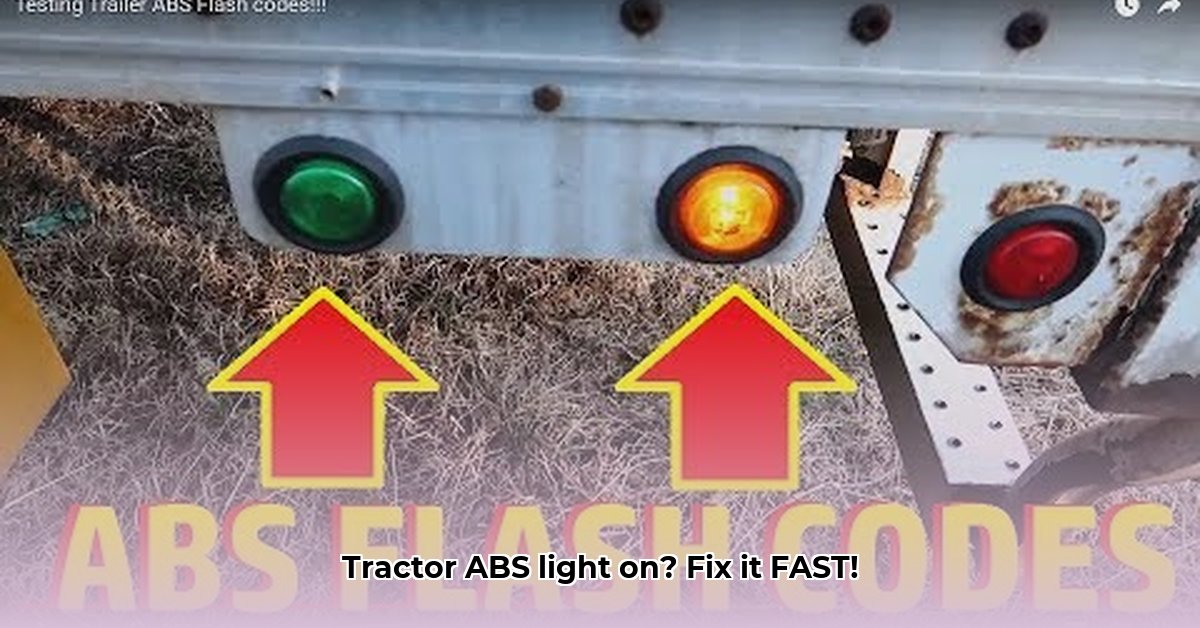
That flashing ABS light on your tractor's dashboard can be concerning. It signals a problem with your anti-lock braking system (ABS), potentially affecting your ability to stop safely, especially in challenging conditions. This guide provides a step-by-step approach to troubleshooting and resolving the issue, catering to both experienced mechanics and novice tractor owners. Let's get your brakes back to peak performance. For more in-depth information, check out this helpful resource.
Step 1: Initial Visual Inspection
Before using diagnostic tools, perform a thorough visual inspection. This initial check often reveals straightforward solutions.
Brake Fluid Level: Check the brake fluid reservoir. Is the fluid level low? Low fluid levels can trigger the ABS light and compromise braking performance. If low, add the correct type of fluid (refer to your owner's manual). However, always investigate the reason for low fluid first, as a leak represents a serious braking system compromise.
Wheel Speed Sensors: Locate the wheel speed sensors (consult your owner's manual for their location). Examine them carefully for damage, mud buildup, or loose wiring. Clean any accumulated debris using a wire brush or compressed air.
Wiring Harness: Inspect the wiring harness connecting the wheel speed sensors to the ABS module for any signs of damage, corrosion, or loose connections. Look for frayed wires, broken connectors, or anything that looks out of place.
Step 2: Utilizing a Diagnostic Tool
A tractor-specific diagnostic tool is crucial for accurate diagnosis. Generic OBD-II scanners may not provide sufficient information for tractor ABS systems.
- Connect the Tool: Connect the diagnostic tool to your tractor's diagnostic port (location specified in your owner's manual).
- Retrieve Fault Codes: The tool will display one or more fault codes. Note these codes down precisely. These alphanumeric codes provide essential clues to the problem's source.
- Interpret Fault Codes: Consult your tractor's service manual to understand the meaning of the retrieved codes. Each code points to a specific component or system issue.
Step 3: Troubleshooting Based on Fault Codes
Once you have the fault codes, you can focus your troubleshooting efforts. Here are some common issues and their solutions:
Wheel Speed Sensor Errors: If the codes indicate a wheel speed sensor problem, replace the faulty sensor. Cleaning might resolve minor issues, but replacement is often necessary for persistent problems.
Wiring Problems: If the codes point to wiring issues, carefully examine the wiring harness for damage. Repair or replace damaged sections. Ensure all connections are secure and corrosion-free.
ABS Module Malfunction: A malfunctioning ABS module often requires professional repair or replacement. These modules are complex and require specialized knowledge and equipment.
Hydraulic System Issues (Beyond Low Fluid): Beyond low fluid, other hydraulic problems (leaks, etc.) can trigger the ABS light. These require a thorough inspection of the entire hydraulic braking system by a professional.
Fuse Issues: Check the fuses related to the ABS system. Replace blown fuses with fuses of the correct amperage, but be aware that a repeatedly blowing fuse points to a more serious underlying short circuit.
Important Safety Note: Always disconnect the battery's negative terminal before performing any electrical work. Consult your tractor's service manual for specific safety precautions.
Step 4: Verification and Testing
After addressing any identified issues, use your diagnostic tool to check for any remaining fault codes. If the codes are cleared, proceed to the final testing phase.
Test Drive: Take the tractor for a test drive in various conditions to verify that the ABS is functioning correctly.
Persistence of Issue: If the ABS light remains on or the fault codes reappear, consult a qualified tractor mechanic to diagnose more complex problems.
Preventative Maintenance
Regular preventative maintenance is key to preventing future ABS light issues:
- Regular Cleaning: Regularly clean wheel speed sensors to prevent debris buildup.
- Fluid Checks: Frequently check brake fluid levels and address any leaks promptly.
- Wiring Inspections: Periodically inspect wiring harnesses for corrosion or damage.
- Professional Inspections: Schedule regular professional inspections of your braking system.
A functional ABS system is crucial for safe tractor operation. Don't ignore that ABS light—addressing it promptly is a significant step towards ensuring safe and efficient operation.